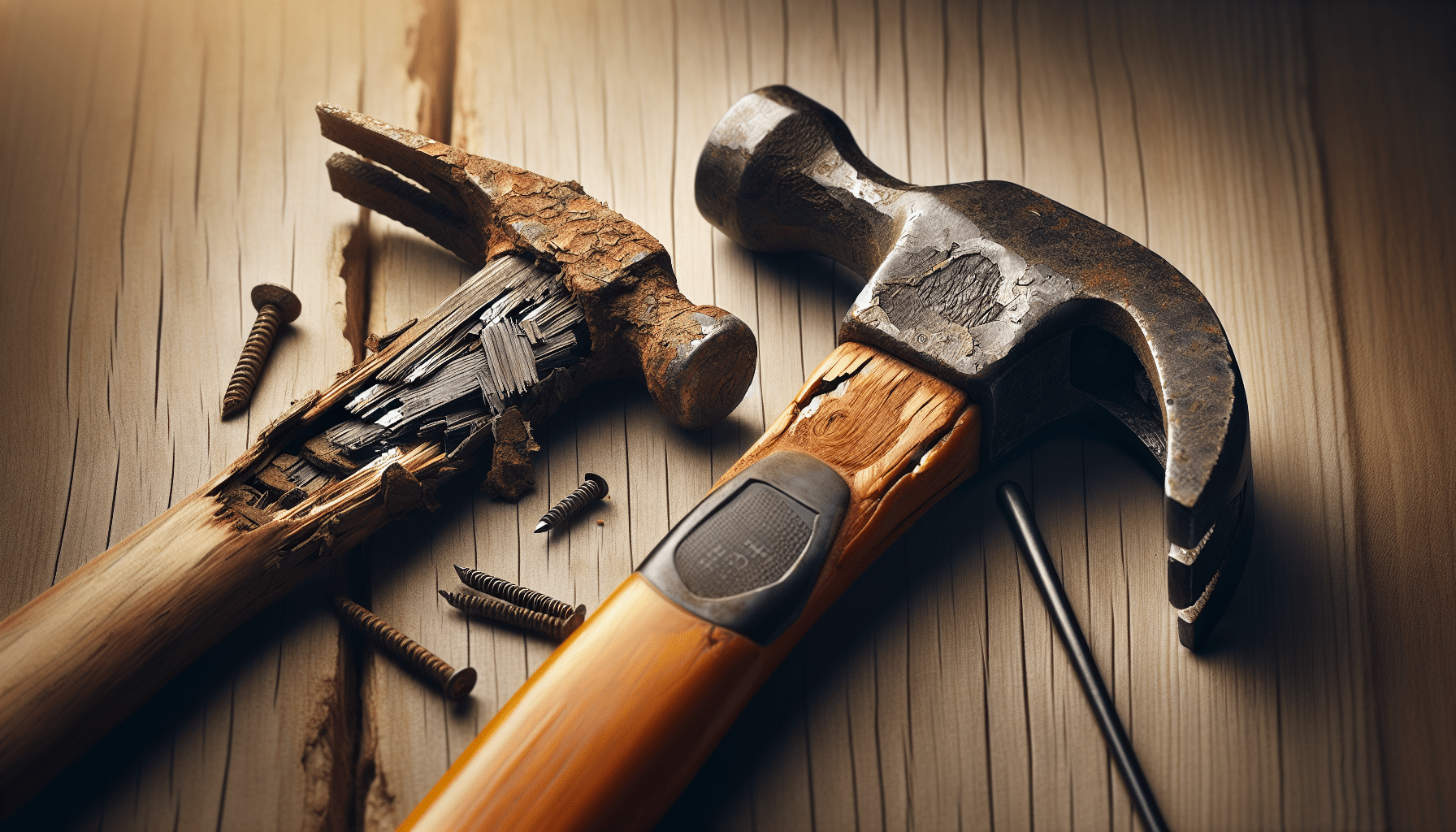In our fast-paced world, it’s easy to overlook the small signs of wear and tear on our everyday items. From the fraying edges of a favorite jacket to the cracking screen of a well-loved smartphone, these signs may seem insignificant at first. However, knowing when to replace or repair these items can not only save you money but also help you avoid larger problems down the road. In this article, we’ll explore some key indicators that can help you determine whether it’s time for a replacement or if a repair is the better option. By spotting these signs early on, you can make informed decisions that will prolong the lifespan of your belongings and keep them looking and functioning at their best.
Understanding Wear and Tear
Definition of wear and tear
Wear and tear refers to the gradual damage that occurs to an item as a result of regular use over time. It is a natural part of an item’s lifecycle and can take various forms, such as scratches, dents, fading, or mechanical failures. This type of damage is different from sudden or accidental damage, which requires immediate repair or replacement.
Causes of wear and tear
There are several factors that contribute to wear and tear on items. These include friction, exposure to the elements, repeated use, and the quality of materials used in the item’s construction. For example, constant movement or pressure on certain parts of a device can lead to wear and tear, while exposure to sunlight or extreme temperatures can cause fading or deterioration of materials.
Common signs of wear and tear
Spotting signs of wear and tear is crucial in determining whether an item needs repair or replacement. Some common indications include rust, faded colors, loose or broken components, decreased functionality, unusual noises, or a general worn appearance. It is important to be vigilant and address these signs early on to prevent further damage and avoid safety hazards.
Factors to Consider
Age of the item
The age of an item is a crucial factor when deciding whether to repair or replace it. Generally, older items are more prone to wear and tear due to longer exposure to use and environmental factors. If an item is reaching the end of its expected lifespan, it may be more cost-effective to replace it rather than investing in frequent repairs.
Frequency of use
The frequency of use also plays a role in determining the extent of wear and tear. An item that is heavily used on a daily basis is more likely to experience faster and more significant deterioration. In such cases, regular repairs may be necessary, but if the item constantly breaks down, it may be more practical in the long run to replace it with a newer, more durable option.
Cost of repair vs. replacement
The cost of repair versus replacement is an important financial consideration. Evaluating the cost of repairs and comparing it to the price of a new item can help you make an informed decision. In some cases, repairs may be a more cost-effective option, especially for minor damages. However, if the repair costs are significantly high or close to the price of a new item, it may be more practical to replace it.
Availability of replacement parts
The availability of replacement parts is another crucial factor in the decision-making process. If the item in question is outdated or no longer in production, finding the necessary components for repair can be challenging. In such cases, replacement might be the only viable option. However, for items with readily available parts, repair can be more accessible and affordable.

This image is property of images.pexels.com.
Signs of Irreparable Damage
Structural damage
Structural damage refers to significant physical harm to an item that affects its overall stability or integrity. This could include broken frames, severe cracks, or bent components. If an item exhibits structural damage, it may be irreparable and potentially unsafe to use. In such instances, it is advisable to replace the item rather than attempting repairs.
Safety concerns
When wear and tear compromise the safety of an item, it is crucial to prioritize the well-being of yourself and others. Signs of safety concerns can include loose or exposed wiring, malfunctioning safety features, or compromised structural elements. If the item poses a risk of injury or further damage, it is essential to replace it or seek professional assistance for necessary repairs.
Inability to function properly
If an item is no longer performing its intended function properly due to wear and tear, it may be time to consider replacement. For example, if a smartphone’s battery can no longer hold a charge or a kitchen appliance consistently underperforms, repair might not be the best solution. The item’s inability to function adequately can be a clear indicator that replacement is necessary.
When Repair is the Better Option
Minor damage
When an item has minor damage, such as cosmetic issues or small mechanical failures, repair may be the more appropriate choice. Small scratches, dents, or torn upholstery can often be fixed without significant expense. By opting for repair, you can save money and prolong the lifespan of the item, especially if its overall functionality remains intact.
Cost-effective repair
If the cost of repairing an item is significantly lower than its replacement cost, repair becomes an attractive option. Simple repairs or component replacements can be more affordable compared to purchasing a brand new item, especially for items with a higher initial price tag. Before making a decision, it is advisable to gather estimates from reputable repair professionals.
Availability of skilled repair services
When qualified repair technicians are readily available for a particular item, it is often a good indication that repair is a viable option. Skilled professionals possess the knowledge and experience necessary to diagnose and fix various issues. If there are reputable repair services specializing in the item you wish to repair, it can increase the chances of a successful and cost-effective repair.

This image is property of images.pexels.com.
When Replacement is Necessary
Extensive damage
If an item has extensive damage that affects its core functionality, repair may not be feasible or cost-effective. For example, a car with significant engine or transmission issues may require expensive repairs that exceed the value of the vehicle. In such cases, replacing the item with a newer and more reliable alternative is often the most practical choice.
Outdated technology or features
Advancements in technology can render older items obsolete. If an item’s features or technology are outdated and no longer meet your needs or preferences, it may be time for a replacement. Upgrading to a newer model that offers improved functionality, efficiency, or convenience can enhance your overall experience and potentially save you money in the long run.
Constant repairs required
When an item continually requires repairs, it can become a hassle and drain your finances. If you find yourself repeatedly investing time and money into fixing the same issues, it may be an indication that the item has reached the end of its lifespan. Consistently breaking down or experiencing multiple failures is a clear sign that a replacement is necessary.
Unavailability of replacement parts
The unavailability of replacement parts can make the repair process difficult, if not impossible. If an item is no longer in production or the necessary components are scarce, repairing it may not be feasible. Without access to the required parts, repairs could be unreliable or costly. In such cases, opting for a replacement is often the most practical and efficient solution.
Assessing Repair vs. Replacement Costs
Estimating repair costs
To determine the potential repair costs, it is essential to seek quotes from reliable repair professionals. Take into account the complexity of the repairs required, the cost of necessary parts, and the labor involved. By gathering estimates, you can compare the repair costs to the price of a new item and make an informed decision.
Researching replacement costs
Before deciding to replace an item, it is crucial to research and compare the prices of available options. Take into consideration factors such as brand reputation, quality, and any additional features or warranties that may be included. By conducting thorough research, you can determine if the cost of replacement is within your budget and offers good value for money.
Considering long-term costs
When comparing the costs of repair and replacement, it is essential to consider the long-term financial implications. While repair costs may be lower initially, frequent repairs can add up over time. On the other hand, investing in a higher-quality replacement item may result in lower maintenance and repair costs in the long run. Evaluating both short-term and long-term costs is vital for making an informed decision.

This image is property of images.pexels.com.
Environmental and Social Impact
Benefits of repair for the environment
Opting for repair instead of replacement can have significant environmental benefits. Repairing an item reduces waste and helps conserve resources by extending its useful life. It also reduces the energy and materials required for manufacturing new products. By choosing repair, you contribute to a more sustainable and eco-friendly approach, minimizing your carbon footprint.
Supporting local repair businesses
Repairing items instead of replacing them also supports local repair businesses. These establishments often provide skilled craftsmanship and personalized service. By patronizing these businesses, you help create jobs and support your local economy. Additionally, the expertise of repair professionals can often result in higher-quality repairs compared to self-repair or replacements.
Ethical considerations of replacing functional items
Replacing fully functional items can raise ethical considerations. In a world where consumption is high and resources are finite, it is important to reflect on the impact of our choices. By replacing functional items unnecessarily, we contribute to the cycle of waste and overconsumption. Considering the ethical implications of replacing functional items can help us make more responsible decisions.
Factors Influencing Personal Decision
Sentimental value
Sentimental value can heavily influence the decision to choose repair over replacement. Items with sentimental significance, such as family heirlooms or personalized gifts, often hold a special place in our hearts. In such cases, the emotional attachment may outweigh practical considerations, making repair the preferred option, even if replacement might be more cost-effective.
Emotional attachment
Emotional attachment, separate from sentimental value, can also play a role in decision-making. Items that evoke positive emotions or have become companions in our daily lives may be difficult to let go of. The emotional connection we have with certain objects can make us more inclined to repair them rather than replace them.
Financial constraints
Financial constraints are a practical factor that influences decision-making. Not everyone has the means to replace items whenever wear and tear occur. If budget limitations restrict your options, repair might be the more feasible and economically sound choice. By prioritizing financial stability, repair can help you make the most of your limited resources.
Personal preference
Ultimately, personal preference is a significant factor in the repair vs. replacement decision. What works for one person may not work for another, as personal preferences vary depending on individual circumstances, needs, and values. It is important to consider your own preferences and priorities when making the decision, taking into account the factors that matter most to you.

Tips for Making the Decision
Consulting experts or professionals
If you are uncertain about whether to repair or replace an item, seeking advice from experts or professionals can provide valuable insights. Consult repair specialists, technicians, or relevant professionals who can assess the extent of the damage and provide knowledgeable recommendations based on their expertise. Their expertise can help you make a more informed decision.
Gauging the item’s remaining lifespan
By assessing an item’s remaining lifespan, you can better determine whether repair or replacement is the better option. Consider the overall condition of the item, its anticipated lifespan based on its original quality, and the potential impact of further wear and tear. This evaluation can help you gauge the cost-effectiveness of repair versus replacement.
Weighing pros and cons
To make an objective decision, it is essential to make a list of the pros and cons associated with repair and replacement. Consider factors such as costs, convenience, environmental impact, sentimental value, and long-term benefits. Weighing the advantages and disadvantages of each option can provide clarity and guide you towards the most suitable choice.
Considering alternative options
Sometimes, repair or replacement may not be the only options available. Consider alternative solutions that may meet your needs without requiring a full repair or replacement. For example, upgrading or adding accessories to an item might improve its functionality or address specific concerns. Exploring alternative options can offer a middle ground between repair and replacement.
Responsible Disposal of Replaced Items
Recycling options
When replacing an item, opting for responsible disposal methods is crucial. Recycling is often a viable option for items composed of materials that can be recycled, such as plastic, metal, or glass. Research local recycling centers or programs that specialize in the recycling of different materials. Properly recycling replaced items helps minimize the negative impact on the environment.
Donation or resale opportunities
If an item is still in good condition or can be repaired with minor effort, consider donating it or selling it to someone who can benefit from it. Many charitable organizations gladly accept donations of functional items, and online platforms provide avenues for reselling used items. By giving your replaced items a new home, you reduce waste and contribute to a more sustainable economy.
Proper disposal methods
If an item cannot be repaired or repurposed, it is important to dispose of it properly. Research local regulations and guidelines for the correct disposal of specific items. Some items may require special handling due to their potential environmental impact or the presence of hazardous materials. By following proper disposal methods, you help protect the environment and prevent harm to others.
By understanding the definition and causes of wear and tear, recognizing signs of irreparable damage, and considering various factors such as age, frequency of use, cost, and availability of replacement parts, you can make an informed decision about whether to repair or replace items. Taking into account the environmental and social impact, as well as personal factors like sentimentality and financial constraints, ensures responsible decision-making. Ultimately, by taking a thoughtful approach and considering all relevant factors, you can make the best choice for your situation, finding the right balance between repair and replacement.


